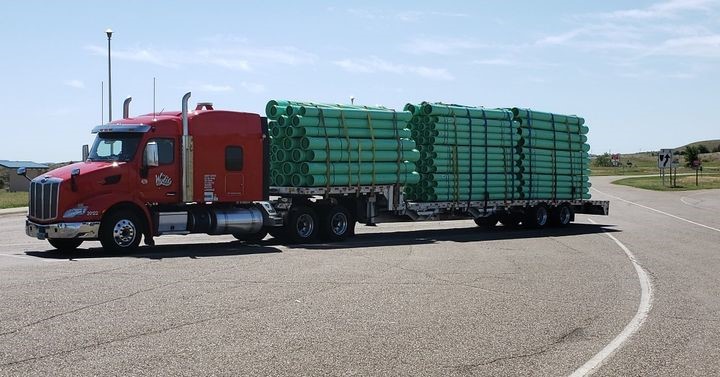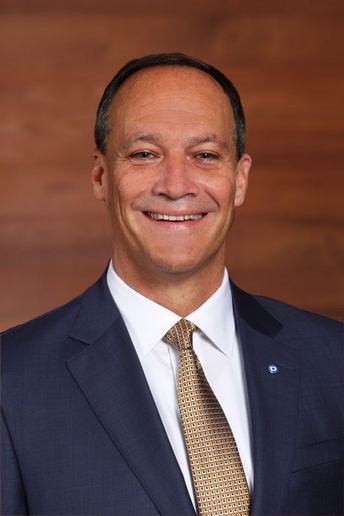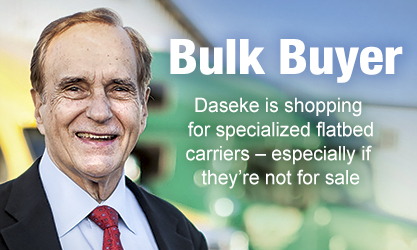Chris Easter discusses Daseke’s transformative year
Don Daseke had a unique vision for the flatbed carrier he built through a decade of acquisitions. But it was time to turn successful top-line growth into bottom-line profits, and that’s where Chris Easter came in.
Daseke bought his first trucking company in 2008, when he purchased Washington-based Smokey Point Distributing. A few years later, he added North Dakota-based E.W. Wylie. He soon decided to build a nationwide company focusing on flatdeck and heavy haul, and embarked on a string of acquisitions over the next 10 years. That included Canadian-based Big Freight Systems and Aveda.

The company grew from $30 million in revenue in 2009 to more than $1.6 billion in 2018, the Dallas Morning News noted last year when Daseke retired from his roles as CEO and board chairman.
“He engineered the growth through a series of acquisitions that made Daseke the nation’s largest flatbed and specialized trucking company.” The company went public in 2017.
But revenue doesn’t automatically translate into profits, and in January 2019, the company publicly announced plans to improve operations after a decade of acquisitions. Chris Easter joined Daseke as the company’s chief operating officer, a newly created position, and last August was named interim CEO. That became permanent in February.
With about a year under his belt leading the company’s efforts, Easter discussed the challenges and changes.

What were your goals and priorities going into this a year ago, and how well do you feel you’ve met them?
Easter: When I joined in January ’19, it was with a mission to drive operational improvement and excellence … and so as I stepped into role of interim CEO, that was still kind of a mandate for us. We had reached what I would call a critical inflection point in the Daseke story. We had built this fantastic portfolio of operating companies but had failed to translate the size and potential of the individual businesses into scale. So, it kind of failed to create shareholder value. We had already begun that shift away from what had been a very successful focus on top-line growth to operational excellence and profitability.
As I stepped in as interim CEO last August, I tried to keep the focus simple. We were close to 100 operating ratio, and there was a long long list of things we would do, levers we could pull, to improve our performance. But what we needed to do was make sure we were focused on the right ones, that would move the needle the fastest, the furthest, and that we had the capability to execute. It was about mobilizing the team around a simple focus point. I said, we’re going to fix and optimize the business, that will then create the value and establish a successful platform operating business so we can get back to growth.
So, this past year has been largely a lot of fixing, a fair degree of optimizing, and I would say the growth we saw was more bottom line, not top line. We started this in the middle of Q3 last year, just mobilizing the team. By Q4 we kind of had a team of leaders structured, taking the existing business leaders and helping mobilize and make sure everybody was aligned in terms of mission and what we were trying to accomplish, and the work began in earnest.
A couple quarters later, here we are seeing the results of that with a significant improvement on the bottom line. We’re pleased with the progress, but by no means satisfied with where we’re at. We’ve got a lot more work to get done, a lot more value to deliver.
Don Daseke set up an unusual way of consolidating companies, where each company still had a lot of autonomy. How much has that changed?
Easter: With the fixing and optimizing, some of the big pieces of those themes were integration. We reduced the number of operating companies from 16 down to nine. There were six integrations, and one divestiture of Aveda in the oil and gas sector. We were able to reduce our total fleet and trailer size somewhat as we gained some efficiencies.
But largely those operating companies continue to operate and execute as great platform companies, and the specialization does lend itself to that. We want to be small where it matters and big where it makes sense. In our business, that local brand, that local operating company is what really matters with your drivers and your customers. That’s where we want to be small. We want to be big in things like procurement. for example, which we still see opportunity there to make more improvements, and systems, and back office functions. There are a lot of things that our size helps to translate into scale.
How has COVID-19 pandemic affected your efforts? How did you deal with it?
Easter: Obviously, none of us want to have to work through such a challenging environment. It certainly has provided challenges. It’s not just a business challenge, it’s a personal thing, every driver is personally affected. I’ve always bragged on drivers. When there’s a hurricane or a crisis, they drive into harm’s way, they’re in many ways somewhat fearless. But usually they have the comfort of knowing their family is safe back home. This was unprecedented, while the drivers are out navigating through this pandemic landscape, their family is having to do It at home as well.
I really think it’s a testament to our drivers and our teams that we’ve kept our execution strategies at a high level. We took it seriously from day one, taking actions to protect the health and well-being of our employees. Like everyone we adapted quickly. In some areas of our business we saw declines, the auto industry out of the gate, aerospace, steel, where you saw declines. But other areas we had strength, wind energy being one, and the lumber/construction folks have held up pretty strong.
But in terms of our transformation execution we stayed very focused. We had a solid plan in place to take costs out; in some ways it helped sharpen our focus on those actions.
How would you characterize the current state of the flatbed market?
Easter: We’re like half or so flatbed and about half specialized; big tentacles across the industrial landscape. I think it’s been improving. A lot of folks described the second quarter as almost a complete cycle in a quarter, with a dramatic drop and then a gradual rise. We see it going kind of sideways since we came out of second quarter. That doesn’t mean there aren’t some segments that have some ups and downs as businesses all adjust to this environment. I think we’ve adjusted our operations where we needed to, adjusted to the pandemic. We’re continuing to execute on our transformation plan and actions. A fair chunk has been done and others are still well in the execution part.
What about the oil and gas market?
Easter: Aveda was our business in the oil and gas sector. We had about 13% of our revenue last year tied to the oil and gas sector, and earlier this year we did make the decision to exit that business and set it aside for sale. That has largely been done. From a revenue perspective, it’s reduced our oil and gas exposure to about 2% of revenue.
Did you decide that before the pandemic cause oil demand to plummet?
Easter: Yes. It was one of those sectors we were looking to optimize, because we already saw some decline on the back half of last year. We were working hard to try to cut costs and improve the performance. The oil business was already suffering with this Saudi-Russia oil conflict, which really sent the oil sector into unprecedented decline. Regardless of the pandemic, with that conflict, it was clear to us that it was an appropriate time, that sector was not the right long-term place strategically as well.
I understand you more than doubled Q2 operating income year over year, despite everything going on, with an OR of 96.5%, the best quarterly performance in Daseke’s history as a public company. How did you do that?
Easter: A year ago, at 100 OR, there was a long list of things we could do to improve that performance. You have to look at multiple angles; what’s the size of the opportunity you’re talking about, what’s the timelines required, and what’s your capacity to execute? There might be a big juicy piece of fruit, but we don’t have the right team to execute right now. We had to prioritize a list and quickly start executing and mobilizing that team.
September of last year, we didn’t have a CFO, we had an interim CFO. We had myself as interim CEO. What I did was identify some of our best operators and business leaders to kind of join me in this interim structure, like Rick Williams [who was founder and CEO of Daseke’s Central Oregon Truck Company] who now is our chief operating officer … and Tex Robbins [who was CEO of 2014 Daseke acquisition Lone Star Transportation] over the specialized segment. The head of our Roadmaster operating company stepped in as our transformation lead. And Phil Byrd, CEO of Bulldog Hiway Express, stepped in to lead our CEO council to help our leaders all navigate through this as well and help us navigate not just for now but also future transformation work.
Now we’ve added a COO, Jason Bates [previously with USA Truck] is a fantastic addition to the team. He joined us during second quarter and we’ve added a few other players at the corporate staff.
What was at the top of the priority list?
Easter: It would be integration. We looked across our business and said Daseke as a company, has 100 OR, and you could say the pricing must be bad or we must be spending too much on recruiting or our empty miles are too high, there’s a long long list. As you look across the organization you say yeah, much of that is true, but it wasn’t a matter of addressing those issues; really the key to our approach was not looking at it from that perspective, because in reality you had nine or 10 operating companies that were doing most of those things very well, but there were a few doing it very poorly. So we looked at it vertically across 16 operating companies and said, ‘Which are the ones that are dragging our performance the most?’ Those first three integrations, phase one, saw $30 million we have already delivered in terms of operating costs.
For the second round we did three additional integrations, and in that case it wasn’t about poor performers, it was more about good performers that maybe aren’t as large in size and we felt we would be able to get value though synergy in terms of bringing together two smaller operating companies or a smaller one into a much larger one.
Don Daseke said he started the business because the flatbed/specialized industry is not run very efficiently. How have you made it more efficient?
Easter: I think the original vision is absolutely where we’re headed – becoming that premiere open deck specialized logistics transportation provider in the U.S. Hindsight’s always 20/20, but the reality is, building out and assembling the portfolio of some of these fantastic operational teams and businesses is unprecedented in our country. It just hasn’t been done before, and it was by no means an easy task. That is the foundation now as you shift the focus of translating that size to scale, that pivotal inflection point that had to be shifted. These companies that were brought into the family, most of those business leaders stayed, and they’re the ones that are driving this transformation.
As we look across the landscape and our competitors, more so in the specialized but flatbed as well, there are many, many small players that don’t have the diversity of business or customers in the markets we do, which I think really has demonstrated the value and resilience of our business in this pandemic situation in how well we can navigate through it and continue to deliver a profit and improve our business. I think that demonstrate the value of the model and the potential for the future. We foresee the potential for this business to be 90 OR or better.
As we fix and optimize, we fully intend to go back to growth. But as we cast a net out in the future for potential targets, it’ll be a much wider net. In the past, we needed to find companies that had the expertise and the teams that had to stay in place, so you needed a certain type of profile. In the future, we’ve demonstrated we can take an underperforming company and integrate it in short order. We’ve also demonstrated we can take a high-performing company and realize gain as well. We’re not quite there yet, but as we continue to demonstrate the profitability of the base company, we’ll be prepared to go back out and cast a much wider net in the future, focus more on targets that we would bring in and most likely integrate into existing companies.
Anything you’d like to add?
Easter: As I look back on this past year, I could not be more proud of the team and how they’ve been able to execute despite the pandemic and all of the pressures that have bene out there, how well this team pulled together and focused and executed. And I know they and I we couldn’t be more excited about our future.
- This interview has been edited for clarity, and was originally published at truckinginfo.com. It is reproduced under an editorial sharing agreement between Today’s Trucking and Heavy-Duty Trucking magazines.

Have your say
This is a moderated forum. Comments will no longer be published unless they are accompanied by a first and last name and a verifiable email address. (Today's Trucking will not publish or share the email address.) Profane language and content deemed to be libelous, racist, or threatening in nature will not be published under any circumstances.